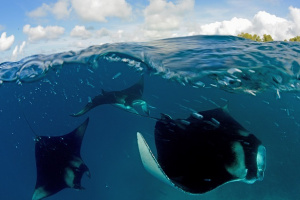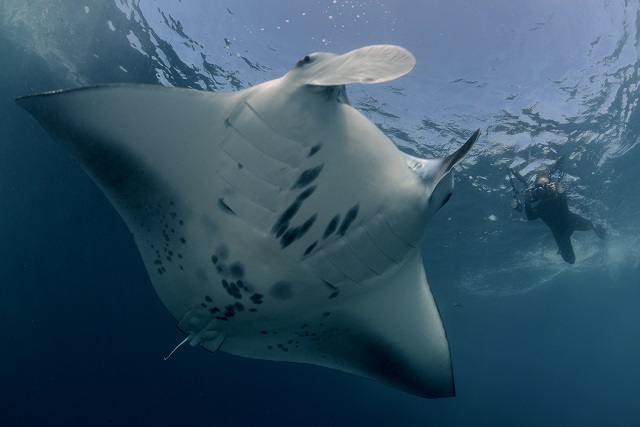Reef manta ray are homebodies, study finds, cementing Seychelles' conservation value
Species |Author: Betymie Bonnelame | August 24, 2020, Monday @ 10:02| 11439 views
Manta rays swimming just off the shore of D'Arros Island. (Dan Beecham)
(Seychelles News Agency) - Seychelles is a critical site for the conservation of reef manta ray as a new study shows that the species seldom venture far from D'Arros island and St Joseph atoll.
The study, which ended last year, was conducted by a Save Our Seas Foundation research centre on D'Arros.
The leader of the project, Lauren Peel, and her colleagues tracked manta ray movement patterns using satellite tags, acoustic tags and the identification of individuals from photographs.
By combining the data from the different methods, the team pieced together a holistic picture of the extent to which reef manta rays are resident within Seychelles, a group of 115 in the western Indian Ocean.
"We had suspected that D'Arros was an important site to reef manta rays because we routinely recognised individuals that returned to the island. We could identify them from photographs, and people were notifying us of repeat visits by individuals they had come to recognise. However, we had no idea of the sheer significance of the site," said Peel.
The previous work of Peel had shown that reef manta rays bring important nutrients to the shallow coral reefs around D'Arros Island from their night-time feeding grounds in deeper water further offshore.
The team, however, did not know much about their broader movement patterns in Seychelles, and that was an important knowledge gap to address because the species faces unsustainable levels of fishing pressure globally.
 |
| The markings on the underbelly of manta rays are unique to each individual and these assist researchers in identifying individuals and monitoring their movements and numbers. (Dan Beecham) Photo License: All Rights Reserved |
Peel added that the new study has improved the team's previously limited understanding of where reef mantas travel in the Western Indian Ocean and showed that even large animals like manta rays can have restricted movement patterns, sticking closely to a preferred area.
These results show the importance of D'Arros Island and St Joseph Atoll to reef manta rays and highlight the valuable role that the marine protected area (MPA) can play in protecting this species.
Most importantly, the study's results highlight the fact that suitably regulated tourism and fishing activities on the Amirantes Bank could benefit conservation efforts for the whole Seychelles region.
It also indicates that if protected areas in the Amirantes Bank were to be extended, they could be beneficial to reef manta ray populations.
"These results are really exciting for Seychelles. We are honoured that our research from D'Arros is helping to emphasise Seychelles as a place of rich marine biodiversity and an important stronghold for sharks and rays in this region," said the founder of the Save Our Seas Foundation, Abdulmohsen Abdulmalik Al-Sheikh.
Reef manta rays are targeted in fisheries around the world for their gill rakers, so knowing where they spend most of their time helps scientists better manage their populations, even where they are not currently targeted. This includes being able to properly designate MPAs where they can protect a species that is declining in other parts of the world.
Back
